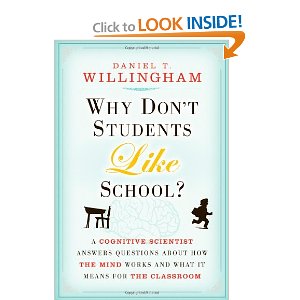
![]() Major Contribution, Itself a Bit Turgid, Easily in the Dirty Dozen MUST READS
Major Contribution, Itself a Bit Turgid, Easily in the Dirty Dozen MUST READS
June 30, 2010
Daniel T. Willingham
I struggled a bit with this book, which is ably and logically presented but does not tell a story as much as it delivers a lecture piece by piece. No doubt my own limitations in play, but this book is so important that I would recommend the publisher sponsor a very small round table including the authors or intellectual sponsors of such books as the five below, with a view to creating a new version of this book that is holistic and actionable on a much larger canvas. Without having read these other books listed below, I would not have appreciated this one as much.
The Leader's Guide to Storytelling: Mastering the Art and Discipline of Business Narrative
Orbiting the Giant Hairball: A Corporate Fool's Guide to Surviving with Grace
The Creation of the Future: The Role of the American University
Public Philosophy: Essays on Morality in Politics
CONSILIENCE. THE UNITY OF KNOWLEDGE.
In this one instance I list four books I have published, with the observation that they are all free online–I am not pimping the books as much as pointing out that no one else is focusing on the education-intelligence-research triangle in this way.
Information Operations: All Information, All Languages, All the Time
THE SMART NATION ACT: Public Intelligence in the Public Interest
INTELLIGENCE for EARTH: Clarity, Diversity, Integrity, & Sustainaabilty
The above begins the review rather than ends the review to set the stage.
The author's own bottom line as I see it is found on page 147:
QUOTE: Thinking is the putting together of information in new ways.”
His signal contribution is nine principles, each with a chapter of explication:
01 People are naturally curious, but they are not naturally good thinkers
02 Factual knowledge precedes skill
03 Memory is the residue of thought
04 We understand new things in the context of things we already know
05 Proficiency requires practice
06 Cognition is fundamentally different early and late in training
07 Children are more alike than different in terms of learning
08 Intelligence can be changed through sustained hard work
09 Teaching, like any cognitive skill, must be practiced to be improved
A handful of key thoughts that stayed with me:
01 Background knowledge matters–the more you know the more you remember, learn, and integrate
02 Deep structure of cognition is more helpful than timeline memorization–see the patterns
03 Intelligence is 50% genetic and 50% environmental, the latter can overcome the former in a good way
04 Failure is a natural part of learning [I would add essential as well]
05 Vital and well illustrated distinction between working memory and long-term memory
06 FEEDBACK is vital to improvement. [I cannot stress this enough, this is where most fail, and especially those that only focus on negative feedback.]
07 Keeping students interested is the heart of the matter [Their presence is not to be taken for granted and not be confused with their engagement]
08 Must reach ALL of the students, not just the attentive ones, that is the measure of a great teacher.
The bibliography at the end of each chapter is especially valuable as the author takes the trouble to isolate less technical recommended sources at the beginning, generally one or two, and then lists more technical resouorces.
This is clearly an essential reading for all those who aspire to teach or to lead. As an intelligence professional I have long realized that “intelligence” in the national government sense is in fact nothing more than remedial education for errant policy makers long divorced from reality, so this book is without question relevant to every aspect of humanity, not just to those doing the elementary to advanced education in a structured manner.
The book does not address external information pathologies including the commercialization of universities, the prostitution of learned journals and societies, the many forms of misinformation and deception that politics and economics have spawned, or the larger issues of collective intelligence, conscious evolution, and so on. For that, visit Phi Beta Iota, the Public Intelligence Blog, and see the reveiews in those categories, each review leading back to the reviewed book's Amazon page.
The author is a pioneer. He has blazed a clearly-marked trail here. Someone else is going to have to come in and trim the sides, lay down the rock, and tamp the trail down. The books I list at the beginning are much morethan “trim” and more like additional ingredients that this book can catalyze into something with a great deal more weight as we go forward.
Afterthought: I did not see anything to recall on team learning, learning to learn, the urgency of returning to an emphasis on liberal arts education before specialization, nor on the urgency of apprenticeships in the trades during high school and the professions during college, nor on the urgency of instituting life-long continuing education patterns, recertification of competency over time, and so on. Much remains to be done. This book is a cornerstone, not the building, not even a single wall.




